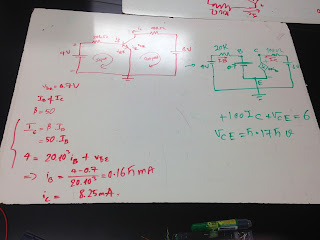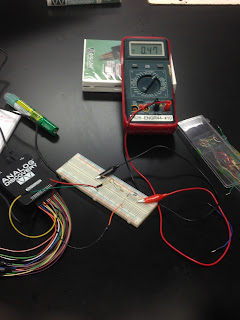Part 1: Maximum power
Grapfrom formula
The condition so that gaining maximum power: Rl = Rth. The formula of P in terms of Rl: P(Rl) = [Vth^2]/(Rl +Rth) * Rl.
The analysis of power formula in terms of Rl. P(Rl) = f(Rl)*g(Rl). f = [Vth]/(Rl +Rth), g= Vth* Rl. Graph of P is the combination of f*g.
The maximum power problem. Firstly, we need to find the Thevinen circuit, with Vth and Rth. The maximum power of Rl occurs when Rl = Rth.
Require Ah for the motor. Based on the table at 12V for the maximum power at 67.9 A, we find the resistor of the CIM motor 0.177Ohm. 2 CIM and 1 brushless motor connected in parallel. From the table we also have the brushless motor 0.13 Ohm. Req = Rl = Rth=0.052Ohm. Then we find the Power maximum = 2.7kW. Then, we find the Ah, the energy the motor per the energy its energy using in 1A in 1hour.
Professor's instruction
We do a maximum power problem. We get the Thevinen circuit, Vth = 22V and Rth = 9 Ohm. The we calculate the maximum power P=(Vth^2) / (4*Rth) = 13.44 W.
Part 2: Maximum power lab
Purpose: The lab is to help verify the maximum power theory, then observe and analyze any difference between the theory and the experiment.
According to the schematic circuit, we set up the breadboard, analog, wires, and resistors with different values
The resistors and the V(Rl)'s values are measured. Rth = 4.63 kOhm. So, we expect the Rl for maximum power is also 4.63 kOhm.
Form the table and the graph, maximum power is slightly different form our expectation, Rl = 4.98k Ohm instead of 4.63kOhm, so it may be because the internal resistor in the analog.
Explanation of professor Mason for the theoretical graph and the experimental graph of power. There is the additional resistance in the analog causing the graph slightly shift to the right.
Part 3:Source modeling
Practical voltage and current sources are not ideal due to their internal resistances or source resistances. Hence,Voltage division: the load voltage is Vl = [Rl/(Rs+Rl)] *Vs.
Current division: the load current is Il = [Rp/(Rp+Rl)] * Is
The example for the source modeling. Based on the difference between the Vl with and without Rl we have the voltage drop across the internal resistor Rs= (Vs-Vl)/Il. we need to find the current of the circuit. We find current using the relation between the power and voltage load and current load. P=Vl^2/Rl = Il^2*Rl. Rs=2.4 Ohm. So, Vs=12.4V, Rs=2.4 Ohm.
The resistance measurement
In the very last moment of the class, we study about the resistance measurement from the Wheatstone bridge. Analyzing the circuit with the voltage division, when the bridge balance v1=v2 and R2R3 = R1Rx. If R1=R3, Rx=R2. So, we can measure the resistance based on the Wheatstone bridge.
Summary:
Today, we study about the maximum power and the condition of Rl to gain the maximum power: Rl=Rth. Then we apply its in to the robot model, as well as converting the energy into Ah. We also do the maximum power lab, and observe the difference between the theory and experiment due to the internal resistance. After that, we discuss about the source modeling and its internal resistance. Lastly, we study about the Wheatstone bridge and its application in measuring the resistance.



















































